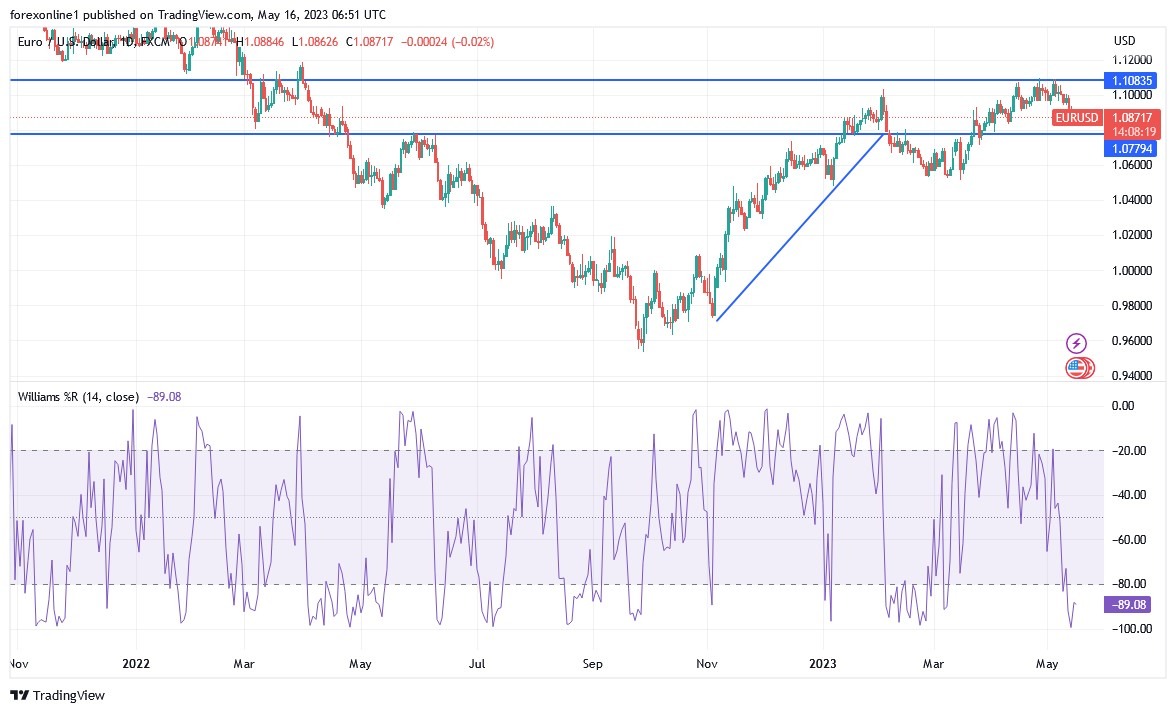The EUR/USD exchange rate rose to stand back near one-month lows as we open this week. It could risk sliding to its lowest levels since late March if transatlantic economic data spoils the market's appetite for the single currency. Yesterday, the EUR/USD currency pair tried to rebound to the upside, but its gains did not exceed the 1.0890 level, recovering in a limited way from strong losses last week that pushed it towards the 1.0847 support.
Prices of the single European currency rose from last week's lows against the dollar in a booming market for risky assets such as stocks and commodities, but remained precarious on the charts ahead of Tuesday's release of first-quarter growth data in Europe and retail sales figures in the United States. Commenting on the performance, Kenneth Brooks, FX Analyst at Societe Generale, says: “The realignment of EUR/USD with bond spreads has run its course and hedge funds held their long position last week at 22.5% OI, so profit-taking looks tactical and not It indicates a fundamental shift is afoot,” the analyst added, “We cannot ignore the risk of a deeper downturn, of course, especially if US retail sales come out strong. The confluence of the 100-DMA and the trend line dating back to September 2022 near 1.0800/1.0730 is a crucial support area. A breakout would accelerate a bounce towards 1.05.”
Yesterday's rebound came as the euro seemed to ignore the Eurostat report which indicated industrial production fell more than expected for the month of March. According to the Advertiser, industrial production in the eurozone fell by -4.1% at the end of the first quarter, echoing previous declines reported by statistical authorities in Germany and France when economists looked on average to see a decline of less than 2.5%.
For his part, Bert Collin, chief economist for the euro area at ING, says: “For the coming months, the prospects for the industry look weak. While lower energy costs are a clear boost to more energy-intensive industries, weak demand remains a concern across the board.”
The data could mean that there are downside risks to expectations on Tuesday's second reading of a gauge of European growth for the first quarter, with which economists are looking to confirm modest growth of 0.1%. For his part, Ludovico Sabio, an economist at Barclays, wrote, "The weak economic data suggests that the weakness will extend into April and is consistent with industry playing a drag on GDP for the second quarter."
With inflation rising from 6.9% to 7% last month, the disappointing expansion in the first quarter is unlikely to have any immediate effects on the ECB's interest rate outlook, but that won't stop the data from temporarily souring the market's appetite for the euro. Especially if comparable numbers in China are also weaker than expected, or if retail sales numbers for April surprise positively in the US later in the day.
Technical analysis of the euro pair against the dollar:
- EUR/USD is starting to bearish and is moving inside a descending channel on its hourly time frame.
- The price is bouncing from the support and it may be due to the falling resistance around 1.0925.
- The Fibonacci retracement tool shows additional levels where sellers can jump.
- Where is 38.2% Fibonacci at 1.0907, then 50% Fibonacci at 1.0927 near the top of the channel and the 100 SMA is a dynamic inflection point.
On the subject of moving averages, the 100 SMA is below the 200 SMA to indicate that the overall trend is still bearish or that selling is more likely to resume than to reverse. The gap between the indicators is widening to indicate the consolidation of the bearish momentum. The bigger correction might reach 61.8% Fibonacci near a small psychological mark at 1.0950, but a break above this might indicate a reversal from the downside trend.
Stochastic is moving higher to reflect bullish pressure, but the oscillator is already closing in the overbought area to indicate exhaustion. A shift lower means that the sellers are starting to take over, so EUR/USD could resume the slide to the swing low around 1.0842 or lower. The RSI has more room to run before reaching the overbought zone, so buyers can stay in control for a while longer.
Ready to trade our Forex daily forecast? We’ve shortlisted the top forex brokers in the industry for you.

